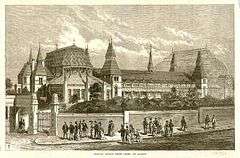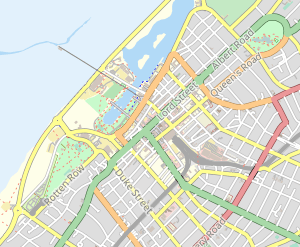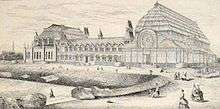Southport Winter Gardens
The Southport Winter Gardens was a Victorian entertainment complex in the town of Southport, Merseyside. The original winter gardens comprised a theatre, opera house, aquarium, a small zoo, conservatory, promenades and halls situated under the grand glass domes.
| Southport Winter Gardens | |
|---|---|
Winter Gardens | |
 Winter Gardens | |
 Location within Southport town centre | |
| General information | |
| Type | Entertainment complex |
| Architectural style | Victorian Germano-Gothic |
| Address | Lord Street, Southport |
| Coordinates | 53.645522°N 3.013033°W |
| Current tenants | Morrisons |
| Construction started | 1870 |
| Completed | 16 September 1874 |
| Demolished | 1933 & 1962 |
| Owner | various owners (majority Morrisons) |
| Height | 80 ft |
| Dimensions | |
| Other dimensions | 180 ft in length |
| Design and construction | |
| Architect | Maxwell & Tuke of Manchester |
History
The Winter Gardens were opened on 16 September 1874, on what was then the sea front at Southport. The building was in the form of two pavilions connected by a covered promenade, designed by Maxwell & Tuke of Manchester.
Layout

The building had two Germano-Gothic pavilions, one of which held a concert hall known as the 'Pavilion', while the other was the iron and glass Winter Garden (known as the 'Conservatory'). The Pavilion had a capacity for 2,500 people and the Winter Garden was a total 180 ft in length with a maximum height of 80 ft. (In comparison, the central section of the Kew Palm House is just over 137 ft long and 63 ft high.) Southport Winter Garden was advertised as the largest conservatory in England and being the first seaside Winter Garden in the UK. Refreshment rooms and an aquarium filled the basement level.
Decline
Although it was one of the biggest buildings ever to grace an English sea front, the Winter Garden was not a great commercial success. The Southport Pavilion and Winter Gardens Company, which promoted it was locally based and had wide support in the town and throughout the north-west with 350 shareholders at its peak, but the addition of Frank Matcham's Opera House on an adjacent site in 1890–91 strained the capital base too far, and the Company went into liquidation in 1898. Many companies rapidly came and went in an effort to save the Winter Gardens in an attempt to turn a profit. Entertainments were lost or driven downmarket, until the Winter Garden was converted into a ballroom and roller skating rink, and the Pavilion became a cinema. Eventually both were demolished, the Winter Garden in 1933 and the Pavilion in 1962.[1]
Opera House
The Opera House was built on Lord Street as an additional attraction to the main winter gardens complex. It opened on 7 September 1891 and was supported by leading dramatic companies in the area. It was designed by Frank Matcham, architect of many theatres in the United Kingdom. The building seated 2,000 people and cost around £20,000 to build. At the time the Opera House theatre was considered nationally to be one of Matcham's finest creations. The venue was a great success and had many well known performers attend including Ellen Terry, Matheson Lang, Sir Henry Irving. In December 1929 a fire raged through the building completely destroying it.[2]
Garrick Theatre
The Garrick Theatre was built during the 1930s on the site of the old Opera House following the fire. It hosted musicals, comedies and dramatic plays. Tommy Handley, George Formby, Gordon Harker, Robertson Hare are to name a few of the well known artists to have performed at the theatre. Today the Garrick is home to a Mecca Bingo hall.
The Ribble Building
Railway Station
The Ribble Building is a former Victorian building that was built on the site of the Winter Gardens to house the Southport Lord Street railway station The Station opened on 1 September 1884 as the Southport & Cheshire Lines Extension Railway's (SCLER) northern terminus, which provided an alternative route to Liverpool City Centre from Southport, which ran coastally through the Sand Dunes. The last trains left the station on Saturday, 5 January 1952.
Bus Station
After the closure of the railway station Southport Lord Street Station was taken over by Ribble Buses. The spaces in between the platforms were filled in, but the rest of the interior remained the same. The train shed remained in use by the bus company until Ribble Buses ceased to operate from the building in the early 1990s. The train shed was later demolished but the frontage on Lord Street was retained and still exists today. In 2014 it was internally converted and opened as a Travelodge Hotel.
Model Village
The first model village in Southport was once situated on the Winter Gardens site and was known as the Land of the Little People. The Model village was demolished in the late 1980s to make way for the aborted Winter Gardens/SIBEC shopping development. The site is now occupied by Morrisons car park and petrol garage.
Winter Gardens Shopping Development
In 1991 the £40million plan known as the Winter Gardens Project crumbled as the construction company responsible for the projects went into receivership, a new developer was sought to continue the construction work on the already half built department store planned for the site.[3] The work was finally completed for the new Safeway supermarket, which opened in the early 1990s, but the Winter Gardens Style shopping centre was never fully completed to the plans. Safeway later extended the car parking facilities and added a petrol garage to their facilities on site. The Safeway supermarket was taken over by Morrisons in 2004. A mural in memory of the Winter Gardens can be seen as you look up upon entering the main entrance to the Morrisons Store on the site today.
References
- http://www.lynnpearson.co.uk/palaces5.pdf
- Grundy, I. (2005) "Playing Bingo - History and Folklore - Southport Garrick, Part 1." http://playingbingo.co.uk/bingo-history-folklore/03-southport-garrick-history-1.shtml#axzz12EEDNWjD
- https://www.constructionnews.co.uk/archive/12apr91-uk-southport-winter-gardens-set-for-sell-off-after-attempts-to-find-new-contractor-are-abandoned-11-04-1991/